A FM Radio for one-dollar – How is this possible?
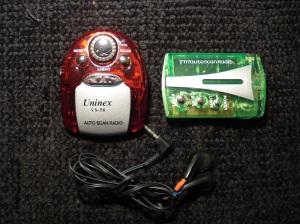 We love Walmart
We love Walmart
On the way out of the Walmart store – right where you check out – the place where smart merchandising people place items for those people who are impulse buyers and those who are unable to delay gratification – I saw a FM Radio for the price of one dollar. For the exchange of one dollar in United States fiat currency I could have in my possession a FM radio. Wow.
The radio runs on 2xAAA batteries, came with a earbuds, tunes the whole FM broadcast band, and has a light. Wow.
The radio runs on 2xAAA batteries, came with a headset, tunes the whole FM broadcast band, and has a light. Wow.
In a few moments, the prize was mine.
Can’t break old habits.
I have heard people tell stories of when they were a kid they liked to take things apart to see what was inside. If you are a kid, maybe 5-10 years old, then its fun taking things apart but unfortunately sometimes they did not go back together. Maybe your parents told you to stop doing this – taking things apart to see how they worked. But for many kids, myself included, one could not resist taking things apart to see what is inside and what makes it work.
At this point I have to mention a related story – you will find it in a past posting on this site. One of my friends, lets call her Elizabeth, has a son of about 10 years and a dog named Diamond. She told me that her son asked her what was inside Diamond. Now, that has got to be the place you draw the line on kids looking inside to see how they work. Although this kid may have a future in medicine lets save the dissection for high school, college, and medical school. Worst case scenario, Elizabeth comes home to find…
Doing the research
Before I opened up the radio I did a search on the Internet to find out about single-chip FM radios. I thought I was on to this radio before I looked inside to read the numbers off the chip
A good bet was the Philips Semiconductors’ digitally tuned TEA5767/68 FM stereo receiver IC
Philips Semiconductors’ digitally tuned TEA5767/68 FM stereo receiver IC is based on an innovative architecture concept that simplifies radio design, significantly reducing the number of external components. Delivering the highest performance levels, this one-chip radio solution occupies minimal PCB area (9×9 mm) making it ideal for all space-critical and low voltage applications such as mobile phones and MP3 players.
The single-chip TEA5767/68 is a miniature, digitally tuned radio IC that utilizes an entirely new radio architecture concept that replaces passive components and complex circuitry, with on-board silicon, drastically reducing the overall bill of materials and making design-in easier. It requires zero external alignments, resulting in shorter design times and lower manufacturing costs due to simplified component placement and reduced logistics overhead. Also, being adjustment free, it delivers increased quality and reliability, both in manufacture and throughout its lifetime in your end application.
If this was it, it looks like I had quite a chip on my hands. This chip interfaces with a microcontroller over a 3-wire bus or a I2C-bus.
Doing more digging I found a application note on the TEA5767/68. This was more information than I ever wanted to know – but very interesting. Turns out that the manufacturer provides a demo board so developers can play with this thing along with software that runs on a PC to communicate with the chip.
Some of the things that the microcontroller can tell the TEA5767/68 single chip FM radio is Mute left/right, search up/down, mono/stereo, set band limits, and set Deemphasis. The Microcontroller can ask the TEA5767/68 status of the tuning, if the band limit is reached during scan, and query a number of settings.
Block Diagram
Demo Board
Software
Talk to me – this is what you can say to the TEA5767/68 over the communications bus
You can find details on all this in the application note in the Resources section of this posting.
What’s inside Diamond?
The appointed time arrived and I decided to deploy the plasma cutting torches and the surgical instruments. I scored two one-dollar radios – one to use and one to explore. The survival of the victim was not of concern to me.
Below is a series of images showing the disassembly
The victims
Inside
Out of the case
The buttoms are Power, Light, Scan, and Reset
When I got inside the radio it was not what I expected. I didn’t find the TEA5767/68. Instead I found an SC1088. Checking the internet, this is what I got
The SC1088 is a bipolar integrated circuit for use in mono portable and pocket radios. It is used when a minimum of peripheral components (of small dimensions and low costs) is important. The circuit contains a frequencylocked loop(FLL) system with an intermediate frequency (IF) of about 70kHz. Selectivity is achieved by active RC filters. Detuning related to the IF and too weak input signal is suppressed by the mute circuit.
Equipped with all stages of a mono receiver from antenna to audio output.
* Mute Circuit
* Search tuning with a single varicap diode
* Mechanical tuning with integrating AFC
* AM application supported
* Power supply polarity protection
* Power supply voltage down to 1.8V
Here is the block diagram for the SC1088
Application Schematic
This is most likely close to a schematic that represents this radio. It some from the datasheet for the SC1088 which you can find in the Resources section of this posting
Give me the China Price
Certainly the TEA5767/68 is for high end applications like mp3 players that have the built in FM radios. If you want the China price then you get the SC1088. From the diagrams you can see that the SC1088 can be set into search mode with a push of a button – no data bus, no microcontroller. The SC1088 is also capable of receiving AM. See the datasheet in the resources section to see its capabilities and application schematics.
I looked for pricing on these chips but it was not available without subitting an inquiry to a supplier.
While doing more research on this I found a few more web sites created by people who like to take things apart. On one of these sites the writer says he bought his single chip radio at Dollar Tree. He says he paid two dollars. That guy got ripped off – I paid one dollar
Conclusion
In 2009 the national conversation is about manufacturing going overseas. How much does it really cost to manufacture a FM radio, package it, get it over to the United States, put it into a distribution center, get it into the stores, and price it for one dollar? Can a retailer like Walmart price this at one dollar and still make a profit?
Resources
TEA5767/68 Datasheet
TEA5767/68 Application Note (highly recommended reading)
Other people wanting to know what’s inside Diamond
http://www.itcbridge.com/forum/view_topic.php?id=634&forum_id=31&jump_to=4389
http://www.users.bigpond.com/cool386/tda7000/tda7000.html
http://www.geocities.com/shreddermanrulz/myth1.htm
What will they think of next – how low can you go?
https://www.silabs.com/products/audiovideo/fmreceivers/Pages/default.aspx
Book recommendation
The China Price: The True Cost of Chinese Competitive Advantage
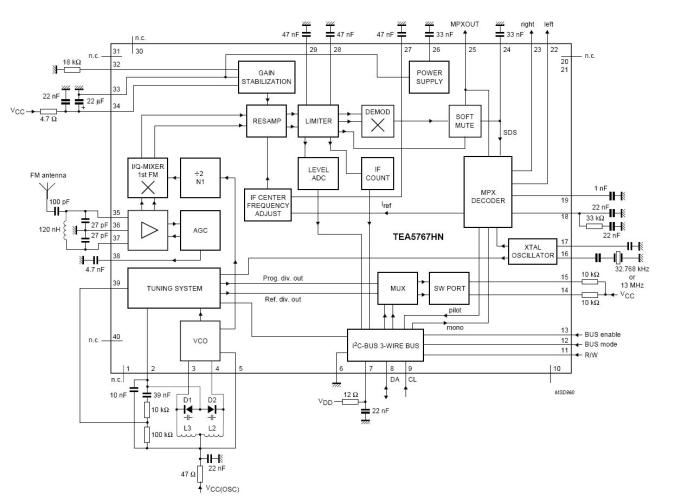
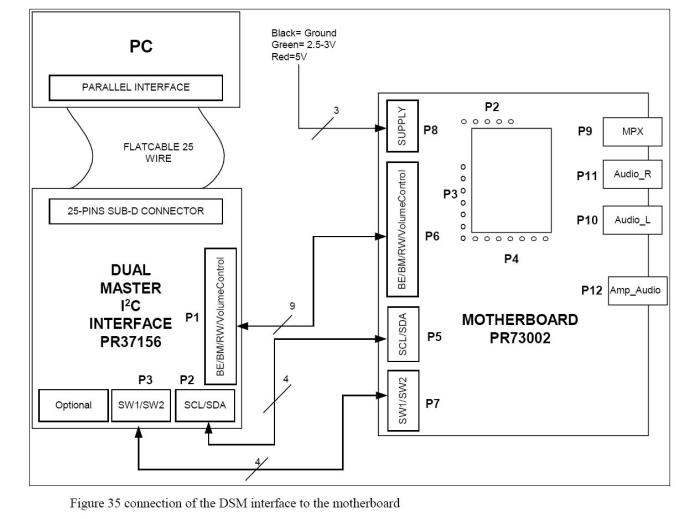

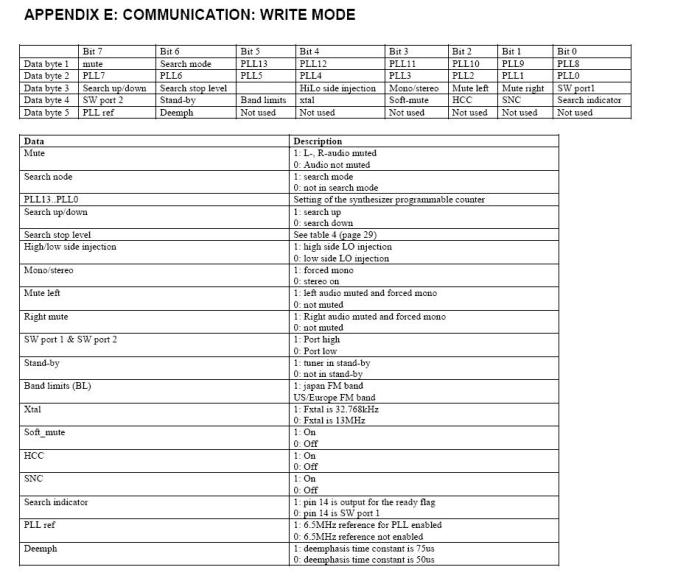


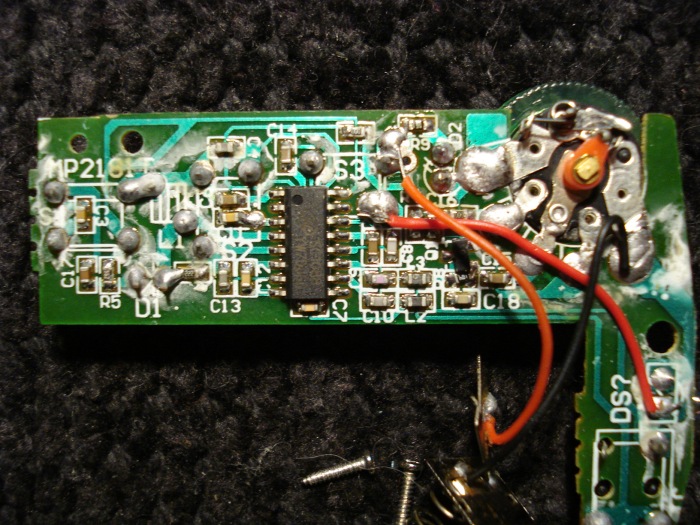



Hi, this is just what I need as working on an SDR, found that the radio chips used in old discarded ‘phones (eg water damaged) are often fine and it is the RF side which is borked.
Interestingly the ones in Nokia 110 (cheap phone) and others notably the S3 Neo can be heard quite a distance away using an SDR with resonant antenna tuned to the IF (old hacker trick), seems that they are somewhat RF noisy in the SW band but this is offset by very good audio quality and who is going to notice when there are so many other RF-hooting devices such as LED lights imported from Cheapassia by the lowest bidder? Heh heh.
Time until someone uses this to track “lost” phones via an Android exploit: Oh, maybe a week.
Conundrum2063
March 26, 2017 at 7:41 am
No doubt someone else will have said this – but just in case: The SC1088 is a Chinese copy of the Philips TDA7088T, so you were on the right track!. The Philips chip is surprisingly old (1991). This (the copying) is part of the reason why the radio is so cheap. Here in the UK similar items are currently selling for one pound.
PS. Everyone copies – it’s a nonsense to think otherwise. How would we progress otherwise?
Bernie
March 8, 2015 at 11:28 am
has anyone managed to manipulate any of the cheaper radio’s into a “franks box” without going into too much technical effort…like either cutting a wire or adding solder…I’m looking for a quick fix so I can get it to sweep channels and I do not have the technical knowledge to add things that are too involved…if so I would love to see pics or tutorial…Thanks
Shawna
November 23, 2012 at 4:27 pm
Franks box is snake oil. I have seen it. I know the idea is great but there have been many ideas that just don’t work. Back in the day an author claimed to hear the dead by just using a cassette tape recorder. In a quiet area turn on and do whatever you do. Play it back and he said it might have to be slowed down as it might sound so fast as to not recognize the noise. Realistically I have been interested in that stuff myself. Unfortunately I know about electronics, and know what Franks box is hearing is not dead people. Very much alive radio broadcasts.
Yes you can even take an audio amplifier touch it with your finger and start hearing radio voices. A lot of things you can do that with. Have you ever heard of people hearing voices in their head. It was from their teeth. I guess a filling had acted like a crystal radio. Must have been a metal filling. The problem with magnetics and or even a high gain rf or af amplifer you stand the chance of hearing radio broadcasts especially when you amplify it to a greater degree. I am not saying it cant be done, I don’t think it has not been done yet. Now we know audio is air vibrations or change in pressure which moves our ear drums. the sun,light,radio waves are electromagnetic waves, we need to find another form of receiving other than electromagnetic and we could have it. It is unfortunate that Frank has played on many to make himself rich. It could be he just doesn’t know the difference. You have heard about an author that claimed to have a device to kill cancer and it cost less than 5 bucks to build. Very simple circuit. You see it is one of those things (snake oil) you cannot prove it doesnt work. Which is the case for Franks machine. He might have thought he heard the dead and you or I cannot prove he didn’t. That is what makes these things so fascinating. and gives us hope and we start to believe just because we want to. I too can build devices and claim I hear the dead and you could not prove me wrong, but I could make a lot of money doing it and make you believe too. We all wish we could speak to our families who have passed on. I know you are saying if there is a chance I have to take it.
yourownfree
September 4, 2013 at 4:03 am
The Joe’s box is based on the TDA7088 by implementing two timer circuits that automate the scan/reset functions. In regards to ghostboxes, don’t be a dick dude!
William Pimblott
January 16, 2017 at 5:41 pm
the guy who bought a $2 radio from the DOLLAR store really got ripped off! how did he pay double at a place called “DOLLAR store”? haha!
ed
October 26, 2012 at 4:57 pm
I just picked up a unit at 99 Cents Only (well, these days it’s 99.9 cents, but what the hell). On the face of it, I got an even better deal than you did: mine is a pedometer with built-in FM radio! On the other hand, my package claims to include earbuds and a triple-A battery; those were missing. I presume what happened was that when these little gems didn’t exactly fly off the shelf, someone opened the packages and salvaged the easily-reused stuff.
Anyway, I specifically bought it to take apart. It’s got two separate boards inside – the pedometer/LCD and the radio – attached only by power leads. The radio is the larger board, with the SC1088 (Googling for that chip is what brought me to your site) and some of the sloppiest soldering I’ve ever seen, even in a dollar item. The scan and reset buttons are little clicky dome switches – domes of very thin springy metal taped over concentric solder traces.
The pedometer board, though, seems to have come from a different factory – almost a different decade! The pedo itself is a clever weight/spring pendulum switch; with each step, it momentarily completes the circuit. The display is a 5-character LCD; there are three microswitches for “mode”, “set”, and “reset”. The “mode” button switches between miles/kilometers/calories burned; to calculate, it asks your weight and stride length. The reason I’m listing all its capabilities: all of those functions are handled by a single IC, a little smaller than a grain of rice. Unfortunately it’s covered by a blob of black epoxy, so I probably won’t be able to identify it without destroying it.
Now, I know that this level of power/miniaturization is nothing new… but I’ve just recently started playing with the Arduino, and the idea of packing this much power and functionality into a package this small – and then being able to sell it for less than a buck – is just amazing to me. (Granted, its builders didn’t intend for it to end up at the 99 cent store; the MSRP was probably a good deal higher. But still.)
Marc
September 9, 2010 at 7:09 am
oh, it is a high quality low price design!
nitlogic
March 29, 2009 at 6:05 am